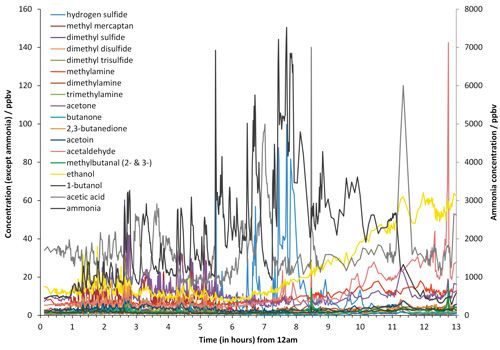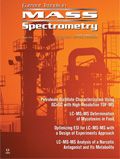Real-Time, Broad-Spectrum Odor Analysis Using SIFT-MS
Special Issues
The sensitive, selective, and real-time analysis characteristic of the SIFT-MS technique provides simple, robust, and continuous analysis of extremely diverse odor compounds at trace levels in air. This application note illustrates instantaneous, broad spectrum odor analysis with monitoring data from a chicken meat production facility.
The sensitive, selective, and real-time analysis characteristic of the SIFT-MS technique provides simple, robust, and continuous analysis of extremely diverse odor compounds at trace levels in air. This application note illustrates instantaneous, broad-spectrum odor analysis with monitoring data from a chicken meat production facility.
Odor compounds are chemically very diverse, making comprehensive analysis very challenging using conventional analytical technologies. Furthermore, odors tend to be dynamic, requiring fast response, whereas odor panels or lab-based analyses are expensive and based on time-averaged samples.
Alternatively, selected ion flow tube mass spectrometry (SIFT-MS) simultaneously detects and quantifies both organic and inorganic odorous compounds in real-time in air to pptv levels with no sample preparation (1,2). SIFT-MS is a direct mass spectrometry technique that utilizes multiple, rapidly switchable chemical ionization agents to deliver unparalleled real-time selectivity, absolute quantitation, and wide linear and dynamic ranges.
This application note illustrates how readily a SIFT-MS instrument can be applied on-site for comprehensive real-time odor analysis.
Experimental Conditions
A van-mounted Syft Technologies’ Voice200 SIFT-MS instrument was deployed at several chicken production facilities in South East Queensland, Australia, during September and October 2013.
Air from the poultry shed was sampled continuously by the SIFT-MS instrument using a flow-past configuration. A sampling pump drew air at a flow rate of a few liters per min through Teflon tubing and the SIFT-MS subsampled it at a flow rate of 25 sccm.
A diverse range of odorous compounds was targeted based on a study using GC–MS (3), augmented with other odorous compounds that are difficult to detect using traditional chromatographic methods (for example, ammonia and hydrogen sulfide).
Results
Figure 1 shows a 13-h snapshot of real-time data obtained while chickens were harvested and the shed cleared of used litter. A diverse range of odor compounds were detected and quantified, including ammonia, amines, hydrogen sulfide, organosulfur compounds, ketones, aldehydes, and organic acids. The odor profile changes dramatically over the analysis period, illustrating the value of continuous, broad-spectrum monitoring using SIFT-MS compared to time-averaged methods.

Figure 1: Comprehensive, continuous odor monitoring using SIFT-MS during harvesting of meat chickens and the subsequent clean out of the production shed.
Conclusions
The real-time, broad-spectrum analysis provided by SIFT-MS makes it ideally suited to continuous monitoring of odorous organic and inorganic compounds even at the very low concentrations required for investigation of odor complaints. The Syft Voice200ultra SIFT-MS solution provides a robust, easily deployed and operated package for on-site monitoring, but is equally at home in contract and research laboratories.
References
- B.J. Prince, D.B. Milligan, and M.J. McEwan, Rapid Commun. Mass Spectrom. 24, 1763–1769 (2010).
- V.S. Langford, I. Graves, and M.J. McEwan, Rapid Commun. Mass Spectrom. 28, 10–18 (2014).
- K.R. Murphy, G. Parcsi, and R.M. Stuetz, Chemosphere95, 423–432 (2014).

Syft Technologies
3 Craft Place, Christchurch 8024, New Zealand
tel. +64-3-338 6701, fax +64-3-338 6704
Website: www.syft.com
